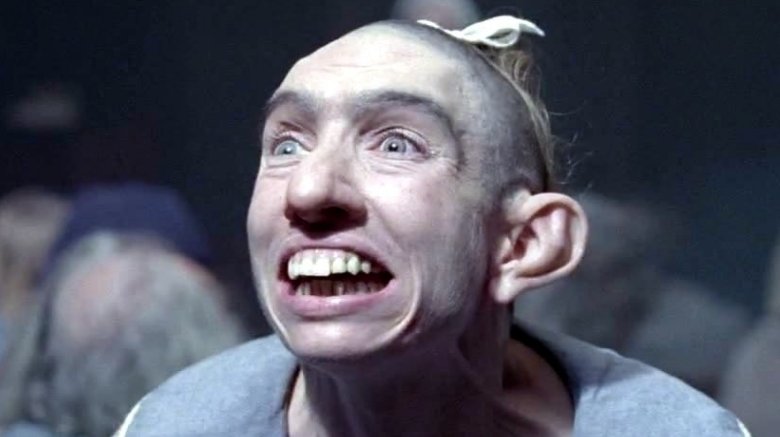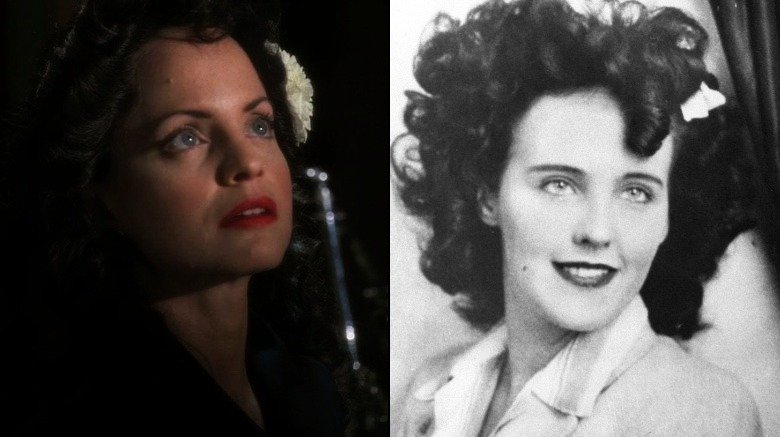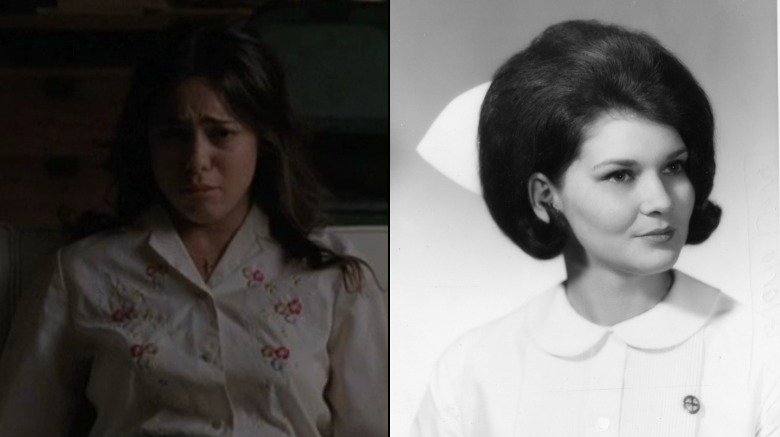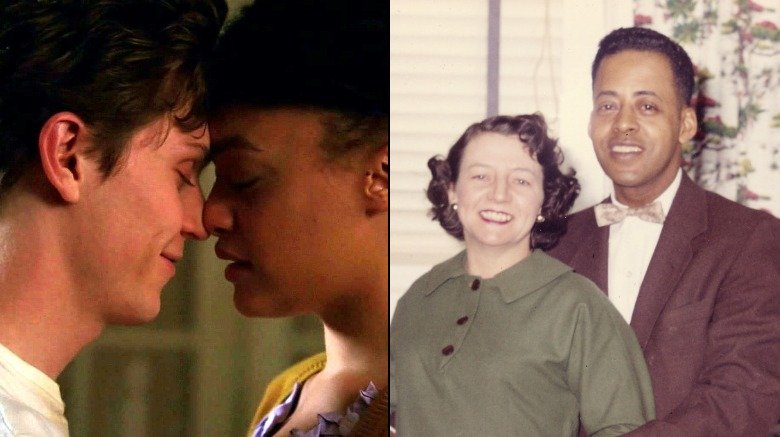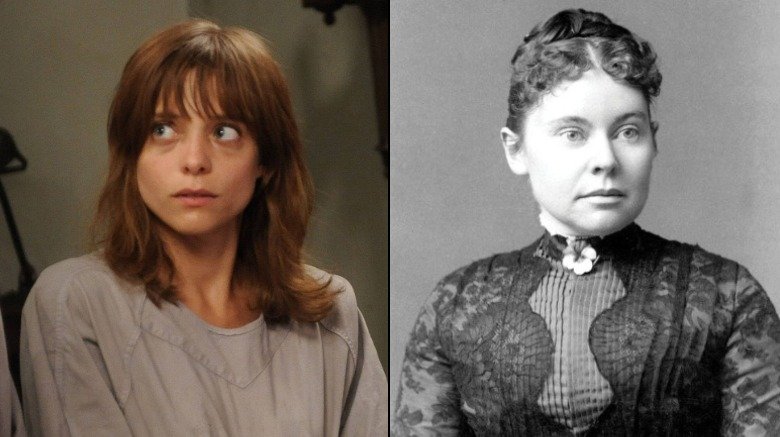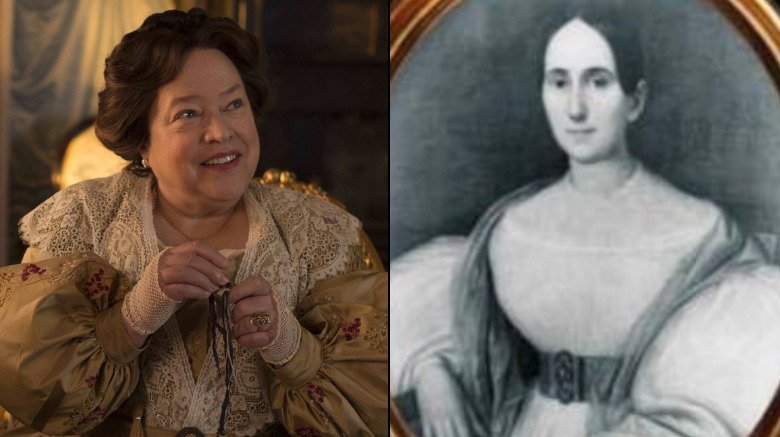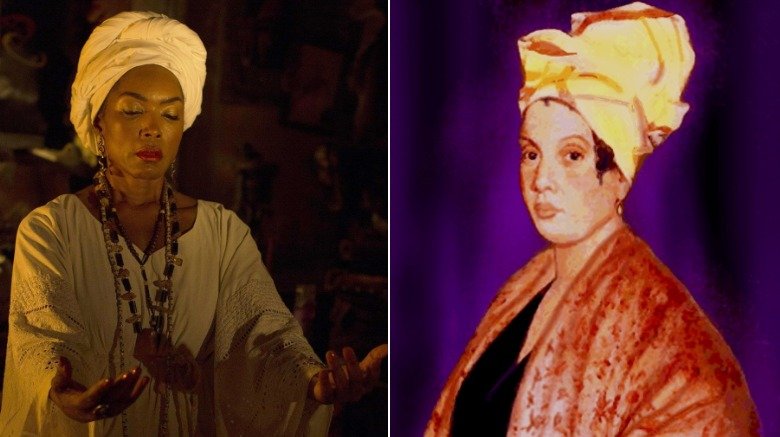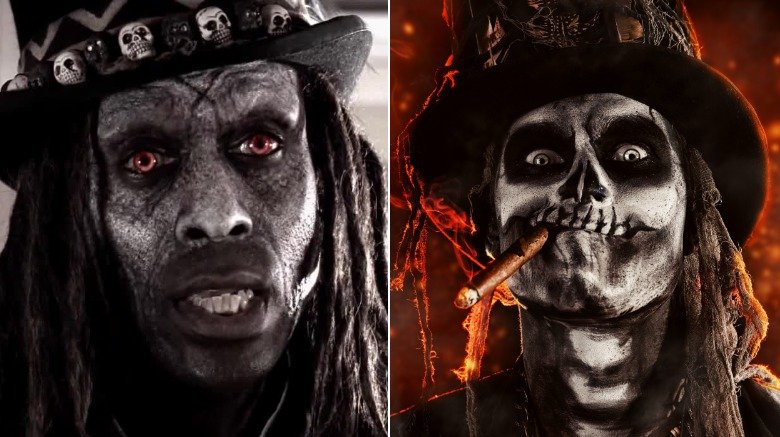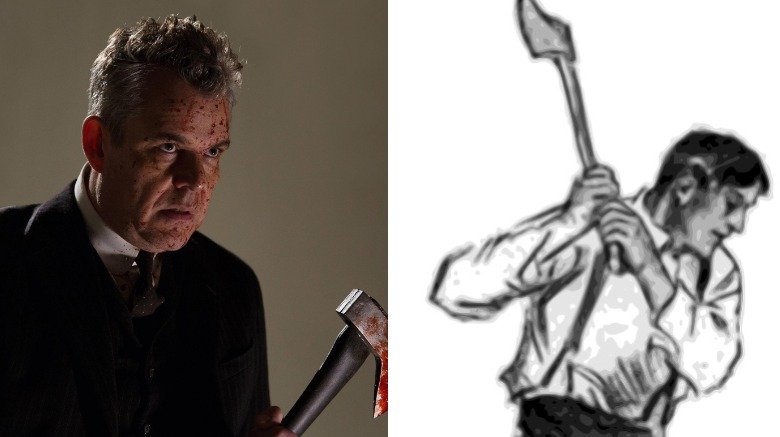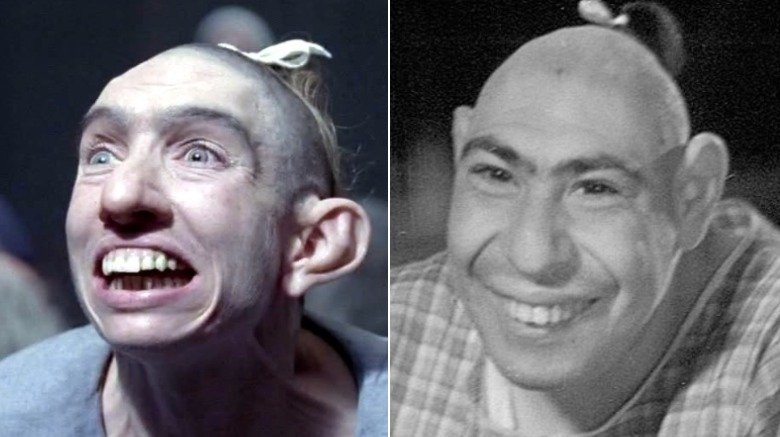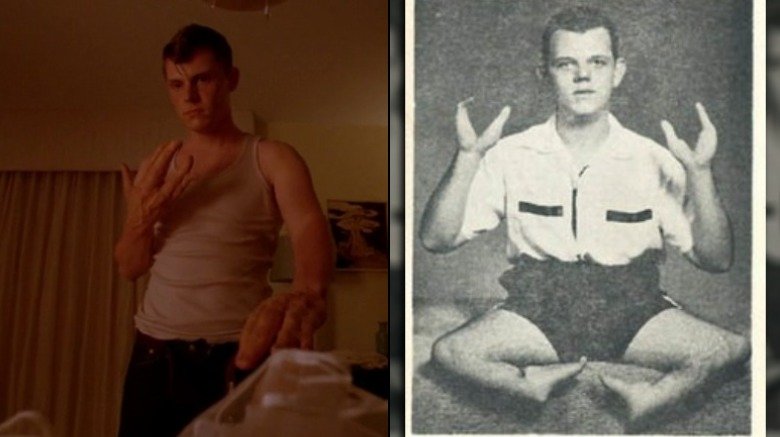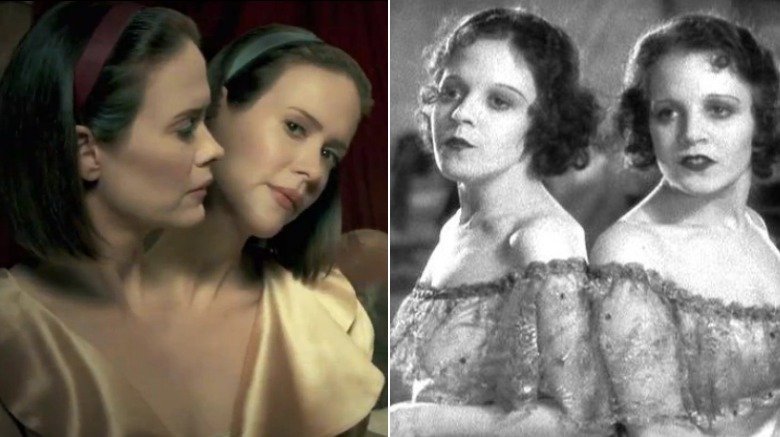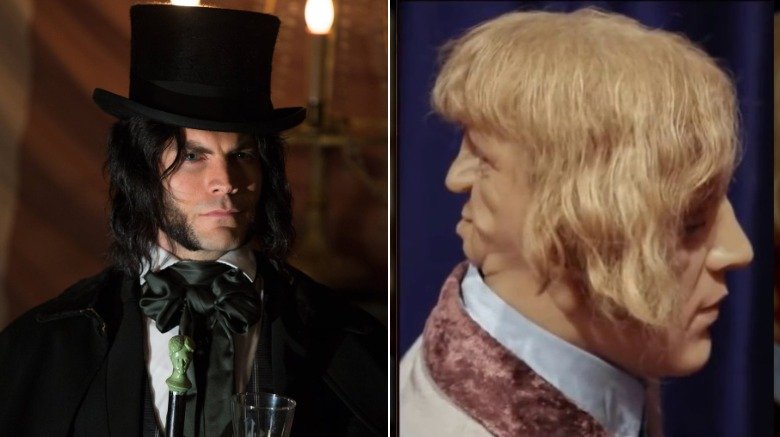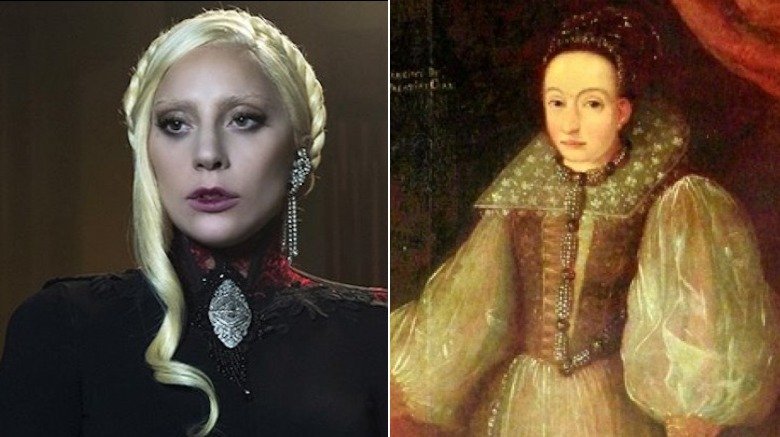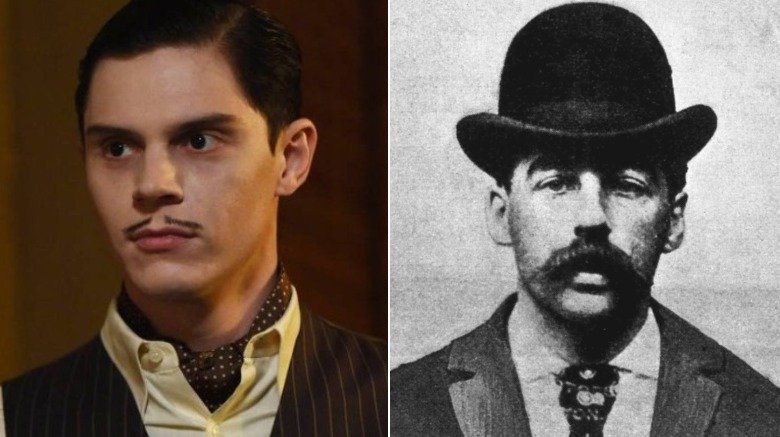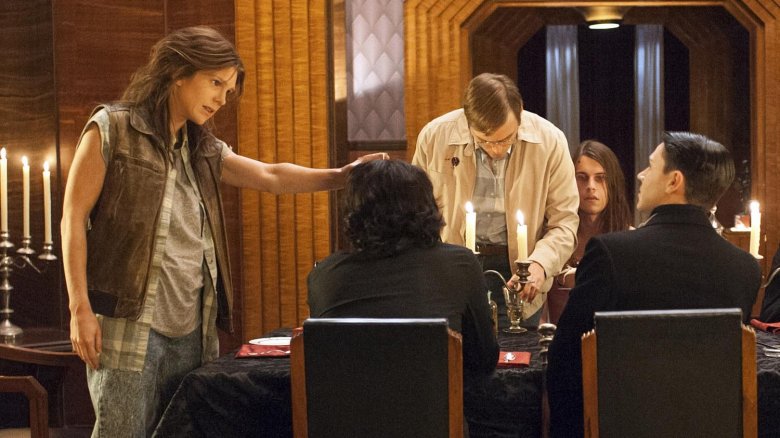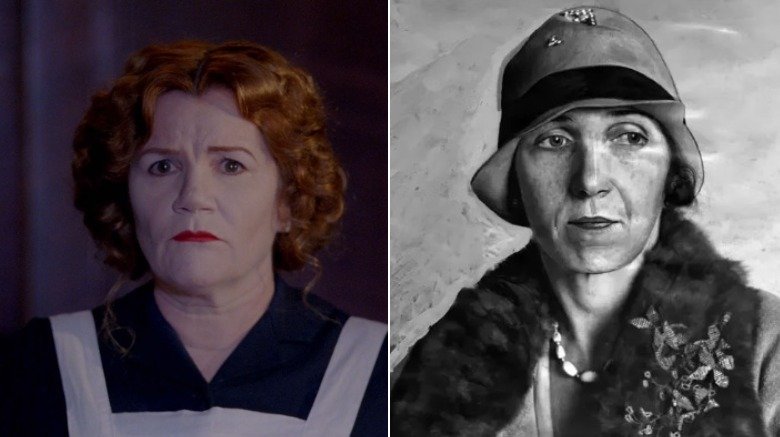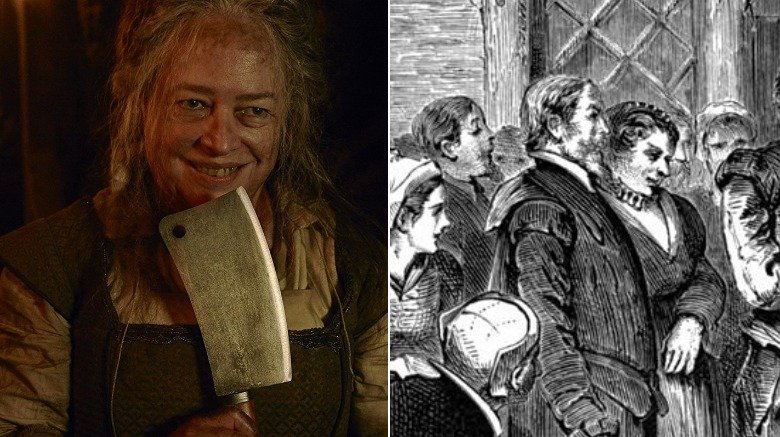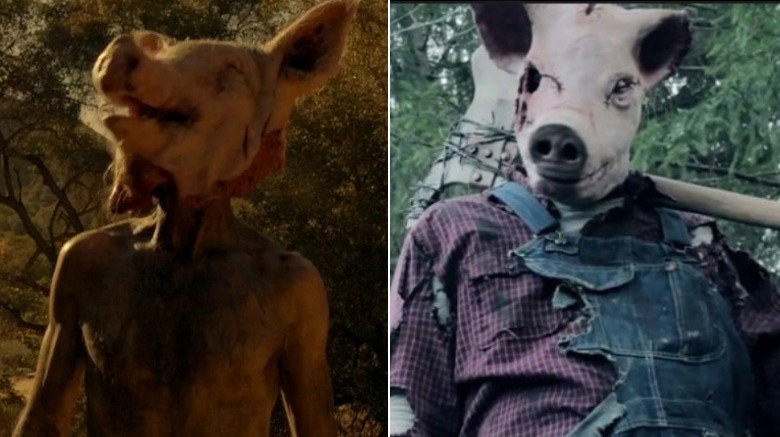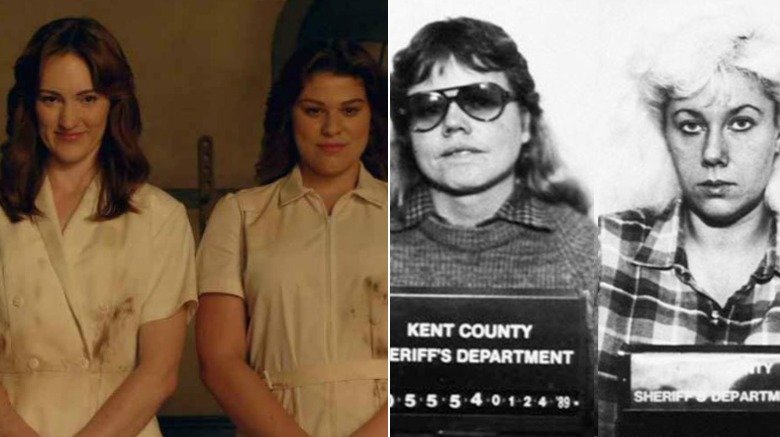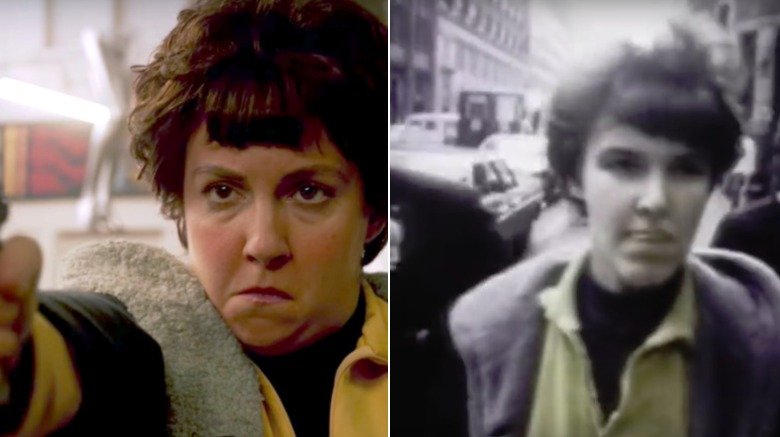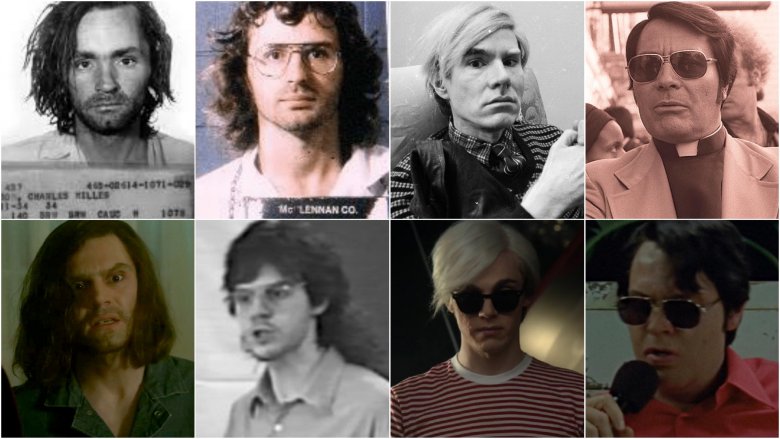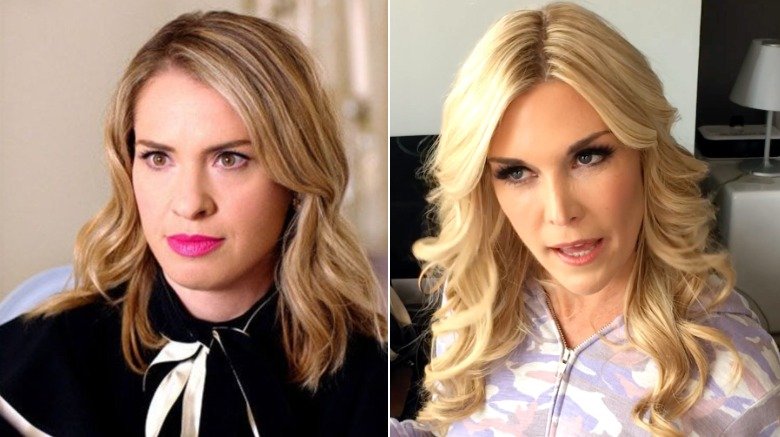American Horror Story Characters Who Are Based On Real People
American Horror Story has spent eight bloody seasons on F/X tantalizing and terrorizing audiences in equal measure. Alongside shows like AMC's The Walking Dead, it was a progenitor for something of a horror television revolution. The anthology series takes on a new concept and new characters with each season (though they increasingly overlap), and features a rotating cast of killers and the victims unfortunate enough to cross their paths.
The resulting stories are horrifying, and made even more chilling when you consider that many are drawn from the real-life murders, both solved and unsolved, that populate American history. Though the show has certainly taken a few drastic liberties with the facts, it's truly disturbing how close some elements of its most outlandish terrors are to reality. We've rounded up a list of the historical facts behind these killer figures that have stalked across our television screens in Ryan Murphy's American Horror Story.
She wanted to be a star at any cost
The first season of American Horror Story was retroactively dubbed "Murder House." It's a fitting name for a season that saw Connie Britton and Dylan McDermott star as Vivien and Ben Harmon, a couple who move with their teenage daughter Violet into a Los Angeles mansion, only to be constantly confronted by the ghosts of those murdered there. Among their many supernatural roommates was Elizabeth Short, known to history as "The Black Dahlia."
Mena Suvari played the AHS version of Short: an aspiring actor, desperate to be famous, who visits the Murder House in the late '40s for a dental appointment that turns lethal. In reality, Short was indeed a Hollywood hopeful who went missing in early January 1947. Her body was discovered six days later near a park, horribly mutilated and posed in a grotesque fashion. The murder was never solved, though one police detective has written a compelling book full of evidence suggesting that his late father, who was a doctor, was responsible.
Only one survived
The second episode of the Murder House season depicts a terrifying home invasion that threatens the lives of Vivien and Violet. Ben works as a psychiatrist, using the house as his office. While Dr. Harmon is away, his patient Bianca returns to the home. It turns out her need for treatment was merely a ruse to allow her, and several friends, to reenact the murders of some nursing students that occurred in the 1960s.
These murders were based on an even grislier series of murders that actually occurred in Chicago in the summer of 1966. Richard Speck, a drifter with a history of violence, gained entry to a residence hall that housed nine nursing students and held them captive. He murdered eight of them (one managed to escape by hiding under a bed) one by one over a period of several hours. Gloria Davy was the last to be killed, and was also sexually assaulted by Speck. He was later caught and incarcerated for his crimes, and died in prison in 1991.
They broke racial barriers
The second season of AHS was subtitled Asylum and focused on the patients and staff of Briarcliff, a sanitarium in New England, during the 1960s. One of the asylum's residents was Kit Walker. He lived happily with his wife Alma until the interracial couple were visited by extraterrestrials who abducted her. A psychological breakdown leads authorities to believe that Kit murdered his missing wife, and he's sent to Briarcliff.
Barney and Betty Hill were the model for Kit and Alma's story, though they thankfully suffered no murder allegations as a result of the visitation they claim to have experienced in 1961. While driving the back-roads of New Hampshire, they saw what Betty described as a shooting star falling upwards that pursued their car. Suddenly the pair found themselves 35 miles from where they had been only moments ago. Their watches had stopped working, and they'd lost two hours of time. Under hypnosis, the couple claimed to recall details of their visitation. They were credible, as it seemed unlikely that an interracial couple in the 1960s would want to draw further attention to themselves. Betty claimed to continue to experience visitations for years following her abduction.
She took an axe...
Another of Briarcliff's unlucky patients is Grace Bertrand (Lizzie Brocheré), a woman accused of brutally killing her father and stepmother. After bonding with Kit, she admits she did murder her family after enduring years of sexual abuse from her father that was sanctioned by her stepmother.
Lizzie Borden's 1892 murder charge and subsequent trial is remembered in an enduring children's rhyme: "Lizzie Borden took an axe/And gave her father forty whacks/When the job was neatly done/She gave her mother forty-one." Lizzie's story was the basis for Brocheré's AHS character. The actual murders came closer to a total 30 whacks of an axe, and Borden was put on trial. She was acquitted of the charges, which mostly amounted to circumstantial evidence. Her testimony was noted for the lack of emotion it displayed, and along with her tense relationship with her parents, it's led the public to question whether she was indeed responsible for the killings to this day.
Her brutality was legendary
New Orleans provides the magical setting for Coven, the third installment of AHS, which draws on the historical legacy of the Crescent City to populate its cast of characters. One of the show's most memorable monsters is Madame Delphine LaLaurie, whose horrific torture of her slaves reaches levels of inhumanity made even more ghastly by Kathy Bates' unsettling performance and the real-life suffering that inspired it.
Bates brings LaLaurie to life over 150 years after the suspected death of the real Madame Delphine, who was born in New Orleans in the late 18th century. She lived a privileged life as a socialite for a time, until reports began to emerge that Delphine mistreated her slaves. The claims were not investigated, though the city did have laws against such abuse. Following the suspected murder of a young slave in her care, LaLaurie's house caught fire in 1834 and revealed the family had indeed brutalized those their workforce — the slaves had been starved, shackled at the neck with spiked collars, and subjected to torture. Enraged by this cruelty, an angry mob ransacked the house, and Delphine fled the city for Paris.
A real-life witchy woman
On AHS, Marie Laveau is a powerful, immortal Voodoo Queen played by Angela Bassett, whose desire for revenge against Madame LaLaurie leads her to form her own cult of followers. In the modern-day timeline of Coven, she alternately makes and breaks alliances with the coven of witches lead by Fiona Goode, descended from the victims of the Salem Witch Trials.
Confirmed details of the life of the real Marie Laveau, a free black woman born to a creole mother and white father at the turn of the 19th century, are scant. The woman herself, a catholic who wove threads of African and Native-American traditions into her religious practice, was reluctant to tell her own story, according to her 1881 obituary in the New York Times. What is known is that Laveau worked as a hairdresser, a detail represented in her AHS counterpart, and that this work informed her role as a spiritual adviser to the wealthy and powerful people of New Orleans, who flocked to her for guidance in matters both personal and professional.
Papa don't preach
Marie Leveau gained immortality within the world of AHS: Coven by making a deal with a stylishly devious devil known as Papa Legba. Legba grants Marie eternal life, but the terms of their agreement require that the Voodoo Queen sacrifice an innocent soul to him annually. A gatekeeper to the spirit world, Legba uses his power to exploit the souls of the living for personal gain.
The AHS version of Legba caused controversy among those familiar with Haitian and West African spiritual traditions, which informed the Voodoo practiced primarily in Louisiana and New Orleans specifically. In those traditions, Papa Legba is not demonic at all. He's invoked at the start of rituals to facilitate communication between the living and the spirit world. The drug-using, top-hatted devil of AHS actually has more in common with the mischievous figure known as Baron Samedi, both in appearance and attitude.
Signed, the Axeman
He terrified the streets of New Orleans on AHS with multiple murders before being trapped by Fiona's coven of Salem descendants, only to be later resurrected and given physical form by the modern-day witches of that same coven. The Axeman of New Orleans later helped the witches enact vengeance against an order of witch hunters who threatened the coven's existence.
The real-world Axeman killed his first victim in 1911, then lay dormant for six years before committing the series of murders that made him famous. Beginning in 1918, the Axeman invaded the homes of over half a dozen people and used their own tools, most frequently an axe, as his murder weapon. The murders targeted Italian immigrant grocers specifically, leading modern historians to theorize that the Axeman was a white laborer who felt threatened by the influx of immigrants to New Orleans at the turn of the century. A letter like the one featured on AHS, supposedly authored by the Axeman, was published in local papers in March of 1919. The murders ended some months later and were never solved.
She was patterned after his career
A traveling show of human curiosities star in the fourth season of AHS. Led by scheming ringmaster Elsa Mars, the carnival performers of AHS: Freak Show are misunderstood by the public, who perceive them as monstrous because of their unique appearances. Among them is Pepper, a microcephalic woman recruited by Elsa after her family abandoned her to an orphanage. Her first appearance was in AHS: Asylum, where her storyline diverged from that of her historical inspiration.
Pepper, as played by Naomi Grossman for Freak Show, was based on Schlitze Surtees, a real carnival performer. Schlitze is thought to be a man named Simon Metz, born in 1901 in Bronx, NY. His parentage is unknown, but his condition relegated his brain development to that of a young child. He performed with the Ringling Brothers Circus and at Coney Island in the late '20s before being cast in Tod Browning's 1932 MGM cult classic Freaks. He took the last name Surtees from his guardian George, a former carnival barker and chimpanzee trainer. Schlitze became one of the most well-known carnival performers of his era, costumed in a dress and billed as a woman.
The Lobster family wasn't a happy one
Jimmy Darling is popular with the ladies, but it's his hands that make him truly remarkable. Born with ectrodactyly, which causes the central fingers to be fused, this malformation earned him the moniker Lobster Boy. A staunch defender of his fellow performers, Jimmy also earns money using his hands to satisfy the sexual needs of bored housewives before losing them to a con-artist who sells them to a museum.
Grady Franklin Stiles, Jr., known as the Lobster Man, was a real carnival attraction whose ectrodactyly condition also affected his feet. His father had the same condition, and brought his young son into sideshows alongside him. The children of Stiles Jr. were also born with ectrodactyl features, and their father followed in his namesake's footsteps by making his children a part of the family business. Together they toured as "The Lobster Family." Unlike Jimmy, though, Stiles Jr. is described by his son Grady Stiles III as a racist and an abusive father who was convicted in 1979 of murdering his daughter's fiance. He died in 1992, himself a victim of murder at the hands of a family friend with ties to organized crime.
These sisters were inseparable
Elsa discovers conjoined twins Dot and Bette Tattler and convinces them join the show. Dot is reluctant, and relents only to please her sister Bette, who dreams of becoming a star. Playing the role of two different sisters on the same series would be a challenge for any actor, but for Sarah Paulson, the challenge was multiplied by having to perform the roles simultaneously on many occasions.
The physiology of the Tattler sisters was inspired by real-life conjoined sisters Abby and Brittany Hensel, whose 2003 documentary Joined for Life was closely reviewed by Paulson in preparation for the part. Yet the story of the Tattlers follows the lives of a different set of twins: Violet and Daisy Hilton. These conjoined sisters, like Bette and Dot, suffered the abuse of their guardians during their early years in show business. The pair toured the carnival circuit and even starred with Schlitze Surtees in Freaks. The sisters saw great success for a time, and eventually liberated themselves from their guardians on the advice of Harry Houdini. Eventually, interest in their act dwindled and they spent their last years working in a grocery story before they passed away in 1969, dying only a few days apart.
He was famously two-faced
Edward Mordrake creeps through several episodes of the series, commanding the various Freak Show performers to reveal the darkest parts of their personal histories so that his spirit can choose one of them to join his supernatural freak show. A second face on the back of Mordrake's head ultimately decides which carnival star is selected. Though real within the world of Freak Show, in reality Edward Mordrake exists only as a hoax, albeit one that managed to fool the public when originally documented in 1896.
Among other hoaxes such as that of a fish-woman and a human crab, Mordrake's tale was printed in the pages of The Boston Sunday Post. Described as a wealthy 19th century man, Mordrake's second face was said to speak to no one but him. The hoax report was later printed in a somewhat reputable medical journal, which lent it credibility. It still managed to fool Facebook users in 2018, when an image that claimed to be of Mordrake's skull circulated online. It was actually just an artist-created sculpture.
Countess bloody Countess
In season five, AHS returned to Los Angeles for Hotel, a collection of stories set within the walls of the fictional Hotel Cortez. It's partially owned by Elizabeth (Lady Gaga, whose performance would earn her a Golden Globe). Elizabeth sometimes calls herself the Countess, and is revealed to be immortal due a blood virus which allows her to sustain herself through vampirism.
The character is styled after Countess Elizabeth Bathory, who was known to history as the "Blood Countess," a 16th century woman born into Hungarian nobility. Her wealthy family reportedly tortured the peasants unlucky enough to live near their estate. When she came of age and married, it's said she also enjoyed torturing servants by driving nails through their bodies, beating them, and even causing some to freeze to death. It was rumored that she bathed in the blood of her victims to preserve her youth, leading to speculation that she was a vampire. Her noble status meant she couldn't be tried for her crimes, but she ended her life imprisoned in a windowless castle.
You can't check out any time you like, and you can never leave
James March built the Hortel Cortez, where the bloody events of AHS: Hotel take place. He married Elizabeth, who delighted in the many murders March enacted on its grounds. March designed the place around his violent tendencies, fashioning rooms that enabled him to commit any number of killings within its walls.
March is clearly modeled on real life serial killer H.H. Holmes, who did build a hotel designed for murder. It featured gas jets, which turned guest rooms into deadly chambers, and a wooden chute that allowed for bodies to be swiftly disposed of in an incinerator. His "murder hotel" claimed the lives of many young women who visited there in connection with the 1893 Chicago World's fair. When he was finally caught, Holmes confessed to the murders of 30 people, though authorities believe he may have been responsible for nearly 200 deaths. He was hanged for his crimes in 1896. His hotel was later intended to be remodeled as a "Murder Castle" attraction but was destroyed by fire before it's opening.
Guess who's coming to dinner?
The fourth episode of Hotel features a deadly dinner party hosted by Mr. March. A who's who of famous murderers check in to attend the festivities, which they've attended annually for many years. The guests of March's party parallel some of the most famous real serial killers in American history.
The first guest to check in is Richard Ramirez, known as the Night Stalker, who was responsible for at least 13 rapes and murders in the 1980s. The next killer to turn up at the hotel is Aileen Wuornos, who confessed to the murders of six men she claimed assaulted her while she worked as a prostitute. Jeffrey Dahmer, who murdered at least 11 people, also turns up. Evidence indicates Dahmer may have consumed some of the remains of his victims. He's joined for dinner by none other than John Wayne Gacy, who dressed as a clown in his free time and also murdered 33 men, but was still charismatic enough to be photographed with the First Lady.
Her son bought the farm... a chicken farm
Mrs. Evers, the laundress for the Hotel Cortez, relates a sad story while the murderous dinner party takes place. She explains that her son Arthur was abducted and murdered on Halloween, lured away from her by a hooded figure. He was later found dead, his body disposed of along with other young victims on a chicken ranch owned by his killer.
The details of Mrs. Evers' tale echo the facts of the Wineville killings, also known as the Chicken Coop Murders. In the 1920s, Gordon Stewart Northcott admitted to killing at least five boys and hiding their bodies beneath his chicken coop. Northcott covered their bodies in quicklime to accelerate decomposition, and even enlisted his mother's help in killing one of his victims. Like Mrs. Evers' son Arthur, Christine Collins' son Walter went missing in 1928. Though his body was never found, he's thought to have been one of Northcott's victims. A boy claiming to be Walter was found by police, but Christine was adamant it was not her son. Police had her committed to a psychiatric hospital, and during her confinement the boy admitted he was actually an impostor named Arthur.
She was real, but she didn't vanish
In its sixth year, AHS decided to change things up a bit and brought us Roanoke, which is styled as a found-footage documentary. Roanoke follows a group of people living in an old mansion known as Roanoke House, near the site of the lost Roanoke colony in Virginia. Roanoke was a real colony from the 16th century that represented the first attempt to establish an English settlement in North America. When the community's founder returned from a two-year voyage, ts inhabitants had all vanished, leaving the the word "Croatoan" carved into a tree nearby.
Another nod to this history is series character Tomasyn White, played by Kathy Bates. White was a real person, and was indeed married to John White, founder of the Roanoke colony. While there's no evidence to suggest she accompanied White to his colony in Virginia, their union produced two children, including their daughter Elizabeth. Elizabeth bore a son at Roanoke, who vanished along with his mother and father and the rest of the colony between 1588 and 1590.
This little piggy didn't go to market
One of the more disturbing ghosts terrorizing the group at Roanoke House is that of a man wearing the decapitated head of a pig. Believe it or not, this isn't just a random image cooked up by AHS producers to give the audience nightmares. The Pigman is a real legend connected to the town of Angola in New York, where the Derreck family lived in the woods around Holland road. Legend has it they removed several railroad ties from the tracks near their home, which later caused the Angola Horror: a deadly train derailment.
Locals claimed Loring Derreck was responsible for the incident, bringing a curse upon himself that led his son William to be born with facial deformities. While there is absolutely no evidence to support the tale, locals claim that William is the Pigman: a butcher who would mount the heads of pigs on stakes nearby to indicate his work wasn't to be disturbed. Allegedly, some teens decided to test this theory and ended up with their heads mounted outside his workshop near Holland road. Legend has it the road is still haunted by the Pigman. It's possible this tale is actually a composite of several legends from the area.
These nurses were deadly serious about their work
Matt, one of the cast members of the show-within-a-show My Roanoke Nightmare, encounters the spirits of Miranda and Bridget Jane. They've been condemned to spend their afterlife haunting the house, which they converted into an assisted living facility while alive with the aim of murdering their patients.
Two nurses known to history as the "lethal lovers" did indeed murder patients under their care in a nursing home in Michigan in the 1980s. Gwen Graham and Cathy Wood fell in love with each other while working at the home, and began a series of murders "in what Wood characterized as a sort of love ritual," according to Rolling Stone. Their union didn't last, and their murders came to light in 1988 when Wood's ex-husband became aware of their activities and brought the information to police. Graham was charged as the mastermind of the crimes and was sentenced to five consecutive life-terms, while Wood has served 40 years and has been eligible for parole since 2005.
She shot Andy Warhol
The 2016 U.S. Presidential election gave AHS plenty of fuel for the story of Cult, their seventh season. In the turbulent post-election times, a cult forms in a small town in Michigan. One of its leaders reveals she had a love affair with none other than Valerie Solanas (Lena Dunham). Solanas is the woman who shot Andy Warhol, the famous pop artist and leader of the studio known as the Factory, which drew artists and luminaries of all kinds to congregate and experiment.
In the AHS universe, Solanas was also responsible for the Zodiac killings. In reality, that series of murders was carried out by an unknown person in the Bay area who taunted police with a series of cryptic messages sent to local newspapers in the late '60s. Solanas only attempted to kill Warhol and Mario Amaya, an art dealer. Both men lived, but Warhol had to wear a surgical corset for the rest of his life. The crime saw Solanas sentenced to three years in prison. She suffered from Schizophrenic paranoia that complicated her rehabilitation, and died in a welfare hotel in San Francisco in 1988.
So many cults, so little time
Evan Peters has always been one of American Horror Story's MVPs, playing various major roles across every season. In Cult, he truly outdid himself — not only did he play Michigan cult leader Kai Anderson, he also portrayed some of history's most famous real cult leaders throughout the season. Among these were the aforementioned Andy Warhol, as well as Charles Manson, Jim Jones, Marshall Applewhite, and David Koresh. As if all that weren't enough, Peters also appeared as Jesus in a brief vision during one episode.
Manson directed a series of murders that terrorized the Hollywood hills in 1969. Jim Jones promised cult followers a Utopia in Guyana, but under his direction it became the site of the largest mass suicide in history. Applewhite also oversaw an infamous mass suicide as the leader of Heaven's Gate. David Koresh led 75 Branch Davidian followers to die in a stand-off with police in Waco, Texas, in 1993.
The Real Housewives of the Apocalypse
It might seem that after eight seasons of murder and mayhem, AHS: Apocalypse would be a fitting end for the series. It features the return of many characters not seen since Murder House, and the title literally signals the end of the world. But it's not the end, says Murphy, who has announced that seasons nine and ten have been approved.
Apocalypse explores a post-nuclear world in which groups of survivors cling to life at various outposts. One such person is CoCo St. Pierre Vanderbuilt, the daughter of a billionaire who has inherited more than a trust fund: she's a witch who studied at the same academy as the members of Fiona Goode's coven from season three of AHS. Actor Leslie Grossman has said in interviews that she very deliberately patterned her character after Tinsley Mortimer, the well-known socialite and star of The Real Housewives of New York City. "I don't see Tinsley as ruthless as Coco is," Grossman told TV Guide, "but just the sort of adult woman who still lives like kind of a little kid."
